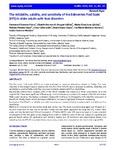Mostrar o rexistro simple do ítem
The Reliability, Validity, and Sensitivity of the Edmonton Frail Scale (EFS) in Older Adults With Foot Disorders
| dc.contributor.author | López-López, Daniel | |
| dc.contributor.author | Navarro Flores, Emmanuel | |
| dc.contributor.author | Becerro-de-Bengoa-Vallejo, Ricardo | |
| dc.contributor.author | Losa Iglesias, Marta Elena | |
| dc.contributor.author | Palomo-López, Patricia | |
| dc.contributor.author | Calvo-Lobo, César | |
| dc.contributor.author | Martínez-Jiménez, Eva María | |
| dc.contributor.author | Romero Morales, Carlos | |
| dc.date.accessioned | 2022-03-24T13:23:27Z | |
| dc.date.available | 2022-03-24T13:23:27Z | |
| dc.date.issued | 2020-12 | |
| dc.identifier.citation | Navarro-Flores E, de Bengoa Vallejo RB, Losa-Iglesias ME, Palomo-López P, Calvo-Lobo C, López-López D, Martínez-Jiménez EM, Romero-Morales C. The reliability, validity, and sensitivity of the Edmonton Frail Scale (EFS) in older adults with foot disorders. Aging (Albany NY). 2020; 12:24623-24632. https://doi.org/10.18632/aging.202140 | es_ES |
| dc.identifier.issn | 1945-4589 | |
| dc.identifier.uri | http://hdl.handle.net/2183/30228 | |
| dc.description.abstract | [Abstract] The Edmonton Frail Scale (EFS) is an index employed to measure alterations related to frailty. The main objective in this research was to develop the EFS short-form (EFS-SF) and to evaluate its validity, reliability, and sensitivity to predict frailty disability outcomes in elderly patients with foot disabilities. Results: Exploratory factor analysis (EFA) of the EFS-SF revealed the presence of three components, as in the original EFA. There were significant differences (p < 0.05) in the study population for several of the EFS and 5-item FRAIL scale indicators. The highest correlation (Pearson R = 0.871; p < 0.001) was found for the first component of the EFS-SF. Finally, the Cronbach alpha was 0.864 which indicated a high level of internal consistency. Conclusion: The EFS-SF is a reliable and valid instrument to measure frailty in patients with and without foot disabilities. Method: A cross sectional descriptive study was carried out. The study population was aged over 60 years (n = 66) and comprised 29 men and 37 women. Frailty disorders were registered by using the EFS, 5-item FRAIL scale, and the Geriatricians’ Clinical Impression of Frailty (GCIF) scale. EFA was employed to locate potential constituents of the EFS, with scores ranging from 0.596 to 0.946 for each of the sub scales: (1) cognitive and general health status; (2) medication and nutrition status; and (3) functional and physiological status, thus revealing that the EFS-SF comprised three components, a reduction compared to the nine in the original EFS. | es_ES |
| dc.description.sponsorship | This research was funded by the Generalitat Valenciana, grant number GV/2020/061 and A.P.C. was funded by the Universitat de València | |
| dc.description.sponsorship | Generalitat Valenciana; GV/2020/061 | |
| dc.language.iso | eng | es_ES |
| dc.publisher | Impact Journals | es_ES |
| dc.relation.uri | https://doi.org/10.18632/aging.202140 | es_ES |
| dc.rights | Atribución 3.0 | es_ES |
| dc.rights.uri | http://creativecommons.org/licenses/by/3.0/ | * |
| dc.subject | Frailty | es_ES |
| dc.subject | Vulnerabilidad | es_ES |
| dc.subject | Elderly | es_ES |
| dc.subject | Ancianos | es_ES |
| dc.subject | Foot deformities | es_ES |
| dc.subject | Malformaciones del pie | es_ES |
| dc.subject | Foot diseases | es_ES |
| dc.subject | Enfermedades del pie | es_ES |
| dc.title | The Reliability, Validity, and Sensitivity of the Edmonton Frail Scale (EFS) in Older Adults With Foot Disorders | es_ES |
| dc.type | info:eu-repo/semantics/article | es_ES |
| dc.rights.access | info:eu-repo/semantics/openAccess | es_ES |
| UDC.journalTitle | Aging | es_ES |
| UDC.volume | 12 | es_ES |
| UDC.issue | 24 | es_ES |
| UDC.startPage | 24623 | es_ES |
| UDC.endPage | 24632 | es_ES |
Ficheiros no ítem
Este ítem aparece na(s) seguinte(s) colección(s)
-
GI-UDISAP - Artigos [196]






